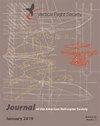Hover Dynamics and Flight Control of a UAM-Scale Quadcopter With Hybrid RPM and Collective Pitch Control
IF 1.4
4区 工程技术
Q2 ENGINEERING, AEROSPACE
引用次数: 0
Abstract
Hover analysis is performed on a 1200-lb gross weight UAM-scale quadcopter with both variable rotor speed and collective pitch control. With these redundant controls, the hover performance and flight dynamics are considered at three trim points, where power consumption can be increased to improve authority of the pitch inputs for changes in rotor thrust. An explicit model following control laws is optimized using CONDUIT R to meet ADS-33E-PRF handling qualities specifications, with design margin optimization on each axis. The responses of the linearized system are examined with either control type, and pitch control is shown to outperform RPM-control in heave, while the opposite is true for yaw. Trim in axial climb is simulated, where the collective pitch can be scheduled with the climb rate to maintain effective stall margin. Hybrid control mixing is implemented using a complementary filter, allowing the aircraft to use pitch control for short-term responses and RPM control for trim. The benefits of this hybrid control scheme are demonstrated through simulation of hot/high/heavy conditions, where trimming with RPM control allows the pitch actuators to maintain margin for maneuvers. It is concluded that hybrid control allows the aircraft to reap the benefits of pitch control for maneuverability while maintaining stall margin by using RPM control for trim.带有混合转速和集体俯仰控制的uam级四轴飞行器的悬停动力学和飞行控制
悬停分析是在一架总重1200磅的uam级四轴飞行器上进行的,该飞行器具有可变旋翼速度和集体俯距控制。有了这些冗余的控制,悬停性能和飞行动力学被考虑在三个修剪点上,在那里可以增加功率消耗,以提高俯仰输入的权威,以改变转子推力。利用CONDUIT R优化了遵循控制律的显式模型,以满足ADS-33E-PRF处理质量规范,并对每个轴进行了设计余量优化。研究了两种控制方式下线性化系统的响应,俯仰控制在升沉时优于转速控制,而在偏航时则相反。在轴向爬升修剪是模拟,其中集体俯仰可以安排与爬升率,以保持有效的失速裕度。混合控制混合使用一个互补的过滤器,允许飞机使用俯仰控制短期响应和RPM控制修剪。这种混合控制方案的优势通过热/高/重条件的模拟得到证明,其中微调与RPM控制允许俯仰执行器保持机动余量。得出的结论是,混合控制允许飞机获得的优势,为机动性的俯仰控制,同时保持失速裕度,通过使用转速控制修剪。
本文章由计算机程序翻译,如有差异,请以英文原文为准。
求助全文
约1分钟内获得全文
求助全文
来源期刊

Journal of the American Helicopter Society
工程技术-工程:宇航
CiteScore
4.10
自引率
33.30%
发文量
36
审稿时长
>12 weeks
期刊介绍:
The Journal of the American Helicopter Society is a peer-reviewed technical journal published quarterly (January, April, July and October) by AHS — The Vertical Flight Society. It is the world''s only scientific journal dedicated to vertical flight technology and is available in print and online.
The Journal publishes original technical papers dealing with theory and practice of vertical flight. The Journal seeks to foster the exchange of significant new ideas and information about helicopters and V/STOL aircraft. The scope of the Journal covers the full range of research, analysis, design, manufacturing, test, operations, and support. A constantly growing list of specialty areas is included within that scope. These range from the classical specialties like aerodynamic, dynamics and structures to more recent priorities such as acoustics, materials and signature reduction and to operational issues such as design criteria, safety and reliability. (Note: semi- and nontechnical articles of more general interest reporting current events or experiences should be sent to the VFS magazine
 求助内容:
求助内容: 应助结果提醒方式:
应助结果提醒方式:


